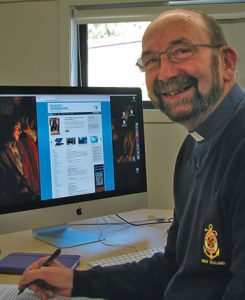Mary is taken up to heaven …
Manihiki is a coral atoll almost 1,300 km north of Rarotonga, the capital of the Cook Islands. It has two villages, Tukao and Tauhunu. The Solemnity of the Assumption is celebrated each year with nothing short of great gusto in one or other of the villages. If there is a priest available, the Eucharist is celebrated, after which there is a torch-light procession through and around the village. During the procession, the Rosary is said, hymns are sung, drums are beaten noisily, and, on one occasion that I recall, a klaxon was employed. All to call attention to the fact that Mary had been assumed into heaven, and the Catholics were rejoicing in the glory that God had bestowed upon her.
The joyous, boisterous and high-spirited festivity seemed to echo the words of the alleluia verse for the Assumption, “Mary is taken up to heaven, and the angels of God shout for joy!”
The tradition of celebrating Mary’s Assumption in this way began in the days of the first Catholic missionary on the island. Fr Ioakimo arrived in Manihiki in 1909, a member of the Congregation of the Sacred Hearts of Jesus and Mary, often known as the Picpus Congegation.
Mary enjoys eternal life with her Son... and so shall we ...
The New Testament says nothing about Mary’s death, or her Assumption into heaven; and, in the first four centuries of the Church’s history, no attention was given to Mary’s place in salvation history, nor were there any particular devotions in her honour. That was because the Church was fully occupied with defining what it believed about Jesus Christ -- is he truly God, truly man, and if so, how?
Towns and countries were in dispute about the answers, giving rise to wars and persecutions, and everyone was interested in the answers to the questions. One of the Church Fathers, Gregory of Nyssa (c. 335 -- c. 395), complained grumpily that he was being asked constantly if he really believed that Jesus was God.
From early days in the Church’s history, Christians prayed to Mary, but it was only after the early Church Councils proclaimed definitively that Jesus Christ was truly God and truly man that they really began to think about her place in salvation history. It was not until the sixth century that people began to celebrate feasts of Our Lady and to wonder about her death. They already believed that Mary was especially holy and had a special place in God’s plan. They began describing her death as special.
In the same way as many Jews believed that when he died Moses was carried to heaven by angels, Christians began describing the death of Mary as her return to God.
Pope Pius XII proclaimed the Assumption of Mary as an article of faith in the Holy Year, 1950. The Church had believed it down the centuries. The pope did not say whether Mary died or not before being taken to heaven; he said that Mary enjoys eternal life with her Son, a goal that we all hope to achieve eventually.
Even though our rejoicing in Mary’s Assumption may not be as exuberant as that of the Catholics in Manihiki, may we take suitable delight in celebrating the glory of Mary, God’s mother and our mother, taken up into heaven. And may we take delight in our faith, that as Mary is, so shall we be.

 Entries(RSS)
Entries(RSS)